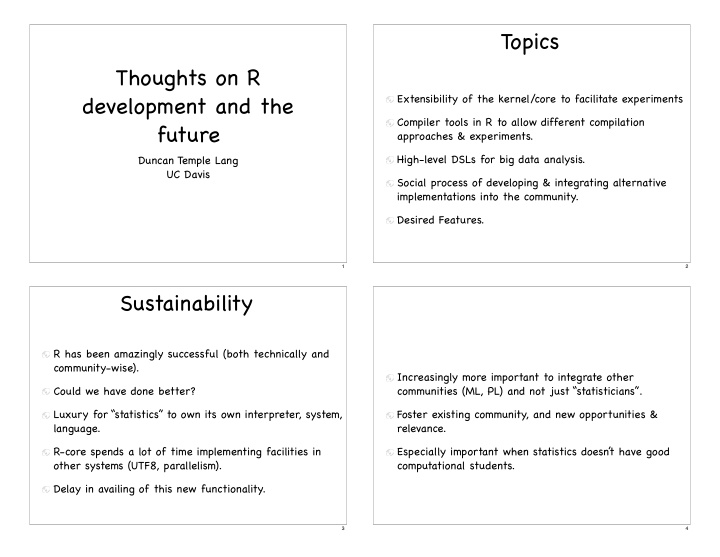



Topics Thoughts on R development and the Extensibility of the kernel/core to facilitate experiments Compiler tools in R to allow different compilation future approaches & experiments. High-level DSLs for big data analysis. Duncan Temple Lang UC Davis Social process of developing & integrating alternative implementations into the community. Desired Features. 1 2 Sustainability R has been amazingly successful (both technically and community-wise). Increasingly more important to integrate other Could we have done better? communities (ML, PL) and not just “statisticians”. Luxury for “statistics” to own its own interpreter, system, Foster existing community, and new opportunities & language. relevance. R-core spends a lot of time implementing facilities in Especially important when statistics doesn’ t have good other systems (UTF8, parallelism). computational students. Delay in availing of this new functionality. 3 4
Extensibility Compilation Tools in R As an alternative to having a byte-code compiler tightly coupled with a VM, explore LLVM Important limitation is that it is hard to make changes RLLVM package provides functions to create IR directly and have them distributed with R. with R calls, focus on user space - packages, not kernel. either compiling R code or some other DSL. Sociology of accepting enhancements/patches Let LLVM do all the work and generate native code Unfulfilled opportunities for others to either participate for CPU, GPU and different targets (JavaScript). or compete with new systems. Goal is to allow others to explore things within current R. 5 6 R function rw2d1 = function(n = 100) { xpos = ypos = numeric(n) for(i in 2:n) { RLLVMCompile is a very simple-minded translator of R delta = if(runif(1) > .5) 1 else -1 if (runif(1) > .5) { expressions into LLVM IR elements. xpos[i] = xpos[i-1] + delta ypos[i] = ypos[i-1] Then compile and optimize. } else { E.g. 2D Random Walk xpos[i] = xpos[i-1] ypos[i] = ypos[i-1] + delta Written in very naieve way for R (no vectorization) } } list(x = xpos, y = ypos) } 7 8
Timings User specifies types for variables Time Speedup potentially annotate the function with these via Interpeted 302.488 1.00 TypeInfo package Byte Compiled 203.226 1.48 or type inference Vectorized 1.549 195.27 type information beneficial for other purposes. Rllvm 0.641 471.90 Can indicate whether there are NAs or not. (Aug 2012, R 2-16-devel) Whether data is mutable or not 9 10 Potential DSLs Introduce new data types, e.g. trees, bignums, big arrays. Instead of users writing procedural code, perhaps they Generate wrappers to 3rd party code (or use dynamic can declare things about the data analysis and have FFI) that be compiled/interpreted. Analyze code to identify dead variables, garbage collect Combine model + fitting algorithm + parallelism strategy + sub-sampling Perhaps recognize potential for memory reuse across segments of scripts. Opportunity because we are in a quite specific domain. Recognize data distribution patterns so transfer subsets Say what you want, not low-level computations that lose to different nodes and execute multiple operations. the big picture. CodeDepends package helps to identify code flow in R. 11 12
R formula language Very different abstraction from model/design matrix Bayesian tools this approach Model description object. Unconnected with data & fitting method. BUGS (Bayesian MCMC) uses this approach. Combine model with fitting algorthim NIMBLE (Paciorek, DeValpine, DTL) Can predict new data, update model, etc. Stan (Gelman et al.) FastLab - Alexander Gray (Georgia Tech) PMML represents models (and results, etc.) Similarly, extended formula language for lattice/trellis plots wireframe( y ~ x1 + x2 | z, data) 13 14 Big Data DSLs Sampling language to describe complex sampling schemes for sub- samples, bootstrap, etc. Goal is to allow people to create composite algorithms without programming, i.e. reuse different steps. Perhaps survey package already has this. Users can still program with general purpose language, Language for indicating how to distribute data and but rewarded for not. computations. Implementors of the pieces can use high-level Goal is to allow descriptions of computations to be used descriptions that are compiled, or use general language. elsewhere and in future systems. Don’ t have to be languages, just high-level descriptions as objects. 15 16
Desiderata Integrating New Implementations More/better facilities for developing software optional type specification interface/contract Provenance and Reproducability Caching and updating results. Some projects outside of the R community have created modified R implementations that are not maintained. Streaming data/block updating algorithm paradigm Approximate results CXXR has very nice features, but minimal uptake. Embedding in other systems (databases, languages Web browsers) Security Compile to stand-alone applications 17 18 Need to seriously consider a plan to adopt/integrate/ combine/coexist different implementations, enhacements. Sustain and maintain the computing environment for community. partner long-term volunteers with shorter term researchers. Try to plan for the inevitable changes that will continue to come - both technical and social. 19
Recommend
More recommend